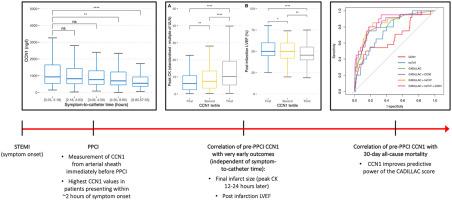Atherosclerosis ( IF 4.9 ) Pub Date : 2021-09-17 , DOI: 10.1016/j.atherosclerosis.2021.09.019 Thabo Mahendiran 1 , Roland Klingenberg 2 , David Nanchen 3 , Baris Gencer 4 , David Meier 1 , Lorenz Räber 5 , David Carballo 3 , Christian M Matter 5 , Thomas F Lüscher 6 , François Mach 3 , Nicolas Rodondi 7 , Olivier Muller 1 , Stephane Fournier 1

|
Background and aims
CCN family member 1 (CCN1) has recently been proposed as a novel biomarker of myocardial injury, improving prediction of 30-day and one-year mortality following acute coronary syndromes. Among ST-elevation myocardial infarction (STEMI) patients, we evaluated the utility of CCN1 measured immediately before primary percutaneous coronary intervention (PPCI) as a predictor of two earlier endpoints: final myocardial infarct size and post-infarction left ventricular ejection fraction (LVEF). Furthermore, we evaluated the impact of CCN1 on the discriminatory power of the CADILLAC score.
Methods
STEMI patients were obtained from the SPUM-ACS cohort. Serum CCN1 was measured prior to PPCI. Linear regression assessed the association between CCN1, peak creatinine kinase (CK), and post-infarction LVEF. Cox models assessed an association between CCN1 and 30-day all-cause mortality.
Results
CCN1 was measured in 989 patients with a median value of 706.2 ng/l (IQR 434.3–1319.6). A significant correlation between CCN1, myocardial infarct size (peak CK) and LVEF was observed in univariate and multivariate analysis (both p < 0.001). Even among patients with normal classical cardiac biomarker levels at the time of PPCI, CCN1 correlated significantly with final infarct size. CCN1 significantly improved prediction of 30-day all-cause mortality by the CADILLAC score (C-index 0.864, likelihood-ratio chi-square test statistic 6.331, p = 0.012; IDI 0.026, p= 0.050).
Conclusions
Compared with classical cardiac biomarkers, CCN1 is potentially the earliest predictor of final myocardial infarct size and post-infarction LVEF. CCN1 improved the discriminatory capacity of the CADILLAC score suggesting a potential role in the very-early risk stratification of STEMI patients.
中文翻译:

CCN 家族成员 1 (CCN1) 是 STEMI 患者梗死面积和左心室功能障碍的早期标志物
背景和目标
CCN 家族成员 1 (CCN1) 最近被提议作为心肌损伤的新型生物标志物,可改善急性冠状动脉综合征后 30 天和一年死亡率的预测。在 ST 段抬高心肌梗死 (STEMI) 患者中,我们评估了在初次经皮冠状动脉介入治疗 (PPCI) 前立即测量的 CCN1 作为两个早期终点的预测指标的效用:最终心肌梗死面积和梗死后左心室射血分数 (LVEF) . 此外,我们评估了 CCN1 对 CADILLAC 评分区分能力的影响。
方法
STEMI 患者来自 SPUM-ACS 队列。在 PPCI 之前测量血清 CCN1。线性回归评估了 CCN1、峰值肌酐激酶 (CK) 和梗死后 LVEF 之间的关联。Cox 模型评估了 CCN1 与 30 天全因死亡率之间的关联。
结果
在 989 名患者中测量了 CCN1,中值为 706.2 ng/l (IQR 434.3–1319.6)。在单变量和多变量分析中观察到 CCN1、心肌梗死面积(峰值 CK)和 LVEF 之间存在显着相关性(均p < 0.001)。即使在 PPCI 时经典心脏生物标志物水平正常的患者中,CCN1 与最终梗死面积显着相关。CCN1 显着改善了 CADILLAC 评分对 30 天全因死亡率的预测(C 指数 0.864,似然比卡方检验统计量 6.331,p = 0.012;IDI 0.026,p = 0.050)。
结论
与经典的心脏生物标志物相比,CCN1 可能是最终心肌梗死面积和梗死后 LVEF 的最早预测因子。CCN1 提高了 CADILLAC 评分的鉴别能力,表明在 STEMI 患者的早期风险分层中具有潜在作用。











































 京公网安备 11010802027423号
京公网安备 11010802027423号